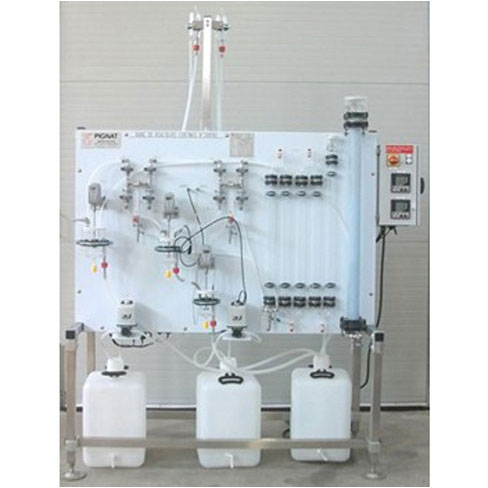Description
Chemical engineering refers especially to chemical reaction engineering. Indeed, chemical reaction, catalyzed or not, are at the heart of all industrial syntheses. Study of a chemical reaction, in a perfectly‐stirred reactor, permits the operator to understand the influence of the different parameters in the optimization of the chemical synthesis with a view to its industrialization.
Features:
- Study and compare four continuous reactors from two different experiments:
- Monitoring the dispersion (NaCl) in water to determine the residence time
- The saponification of ethyl acetate by soda
- Contains four different reactors with the same volume (0.8L):
- One perfectly stirred reactor
- A cascade of two perfectly stirred reactors
- One plug-flow reactor
- One tubular reactor
- Hydrodynamic study of the reactors by the residence time distribution (RTD) method:
- Determine residence times
- Compare theoretical and experimental results
- Determine the chemical conversion rate by conductivity measurement:
- Materials balance, reaction yield
- Compare the efficiency of the different reactors
Proposed Experiments:
- Determine the residence time distribution (RTD):
- Inject a coloured tracer and monitor conductivity.
- Use the experimental conductivity = f (time) graphs to determine the residence time for each reactor.
- Compare the reactors.
- Saponification of ethyl acetate with sodium hydroxide.
- Calibration of conductivity sensors for sodium hydroxide assay.
- Monitor the reaction conductivity and determine the sodium hydroxide conversion rate.
Technical description:
- 60 L feeding polyethylene tanks 60 L with draining valve.
- Peristaltic pump with two heads, fix speed motor.
- Two glass vessels ND 50 for constant feed by overflow.
- Two flow rate meters with a setting valve.
- Two five-way selecting valve.
- Stirring motor, 50 to 2000 rpm. PTFE stirring pipe, Ø 6, length: 400, with four pales helix: Ø 40.
- 1 L glass reactors, ND 100 with PVC cover, overflow connection, measurement well, conductimetric probe, draining valve and tracing injection.
- Two 0.5 L glass reactors, ND 100 with PVC cover, overflow connection, measurement well, conductimetric probe, draining valve and tracing injection.
- Glass piston reactor, 1 L, ND 50, length: 1000 with overflow bell-jar, conductimetric probe, purging valve, stainless steel supporting grate, glass ball packing: Ø 3, draining valve and tracing injection.
- 1 L glass coil reactor, ND 15 with overflow bell-jar, conductimetric probe, purging valve, draining valve and tracing injection.
- 60 L polyethylene tank with draining valve.
General Specifications
- Two diaphragm pumps, variable flow rate.
- Two glass vessels for constant feed by overflow.
- Variable rate Stirrer, SS stirring shaft with SS four blades helix.
- 3 stirred glass reactors, pipe overflow, conductivity and temperature, drain valve and tracing injection.
– 0,8 L perfectly stirred reaction vessel
– 2 x 0,4 L perfectly stirred cascade vessels
- 2 plug glass reactors, 0,8 L, conductivity and temperature measurement and tracer injection.
– 1 reactor coil, empty.
– 1 reactor piston, packed.
Instrumentation
- 2 flowmeters.
- 2 conductivity probes.
- 2 temperature probes Pt100Ω.
Dim : 175 x 70 x 235 cm – 150 kg
SS framework 40 x 40mm
For a complete product data sheet and a list of reference sites please call 1-877-967-2726.

